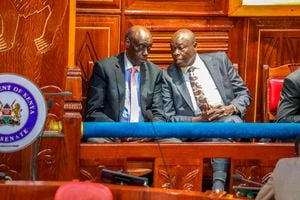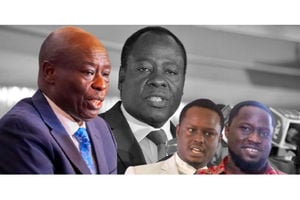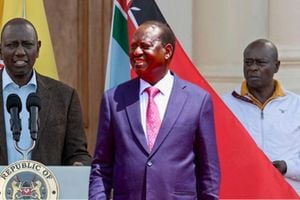
Deputy President Rigathi Gachagua is ushered in the Senate, Parliament Buildings Nairobi on Thursday, October 17, 2024 during the second day of his impeachment.
On October 17, 2024, the Senate impeached Deputy President Rigathi Gachagua. This was hardly a jolt from the blue. After the Gen-Z revolt, President William Ruto pursued an impeachment strategy to replace his second-in-command. Using the ever-shifting elite alliances, he formed a ‘broad-based government’ to secure the numbers he needed to execute the strategy in parliament. In response Gachagua crafted a counter-strategy to scuttle Ruto’s impeachment strategy in courts.
His legal strategists exploited a serious lacuna in Kenya’s new impeachment law. Unlike the America Senate which acts like a high court during impeachment and its verdict is final, Kenya’s Senate is merely a tool of inquiry with no legal force to convict. This leaves the judiciary as the final arbiter in county and national impeachment processes. In the end, the impeachment drama has become a clash of strategies in the battle for the soul of Mount Kenya.
Gachagua impeachment reflects the failure by Kenya’s 2010 Constitution to exorcise ‘the curse of the deputy’ in Kenya’s political system. Of Kenya’s five presidents, only Uhuru Kenyatta has finished his term with one deputy. Gachagua becomes the first deputy President to be impeached under the 2010 Constitution, only 766 days in office.
But Gachagua is also facing the full force of Ruto’s long-term strategy that also fell Kenyatta in 2022. Ruto’s long walk to September 13, 2022 when he was sworn in as Kenya’s fifth President reveals a consummate warrior and strategist. Despite decades of animosity and even violence, Ruto recognised Mount Kenya, more than a quarter of Kenyan vote, as a potential ally to his Kalenjin bloc. Patience was Ruto’s safest ship to power. Even when his closest allies were removed from Government on allegations of corruption in March 2015, he kept his eyes on the larger picture and steered clear of confrontation with Uhuru, continue holding the Deputy President’s office to solidify his power. Ruto quietly prepared for the 2022 presidential war, becoming a presidential front-runner. Obviously, Gachagua missed this lesson, and failed to triumph over the age-old ‘curse of the deputies’.
Mount Kenya constituency
Why did the President move so swiftly to remove his second-in-command, despite the risk of losing his Mount Kenya constituency ahead of the 2027 re-election? Simple. He had first-hand evidence of how a rift between him and Kenyatta hobbled the Jubilee government. Gachagua’s sins were more of commission than omission. As relations with his boss dipped, he moved to curve an ethnic base in Mount Kenya, fashioning himself as the kingpin and fierce defender of the bloc and coining the phrase: “usiguze mlima”, which means “don’t touch the mountain”. Viewed in this context, his idea of “Government-as-company” and “citizens as shareholders” was seen as an idiom of exclusion.
In June, Gachagua blamed the Director-General of the National Intelligence Service (NIS) for not properly briefing Ruto and the government over the magnitude of mass protests against unpopular tax hikes. Even worse, he addressed the media after his boss had spoken. This fueled the accusations that he was undermining security, the president and promoting ethnically divisive politics when he was expected to be a national unifier.
In removing his second-in-command, Ruto’s strategy has familiar echoes in Sun Tzu’s The Art of War: “Let your plans be dark and impenetrable as night, and when you move, fall like a thunderbolt.” Ruto saw an opportunity in the chaos of the Genz revolt, using Kenya’s ever-shifting elite alliances to coble an ‘opposition strategy’ in a classic carrot-and-stick fashion. He popularized the idea of a ‘broad-based government’, reshuffled his cabinet, appointed four top officials of Odinga’s ODM to four dockets of the cabinet and officially unveiled the opposition leader as the country’s candidate for the chairmanship of the African Union Commission (AUC). Like Ruto under Uhuru, Gachagua complained of being sidelined by the president and being kept in the dark about important events. The entry of ODM into the Government boosted anti-Gachagua forces in Government, parliament and senate. ODM seats and Kenya Kwanza gave Ruto a super majority in the National Assembly and more increasingly the Senate. The National Assembly also picked a close associate of Odinga, senior counsel James Orengo, to head its legal team during the impeachment trial. While this could be a poisoned chalice for Ruto, it can also be a boon in the drama of elite alliances in 2027.
Long before the National Assembly voted 282-44 to impeach Gachagua on October 8, 2024 and Senate upheld five out of 11 charges against him on October 17, he had already crafted a counter-strategy. Gachagua realised the gap in Kenya’s impeachment system. In the United States, the Senate sits as a High Court of Impeachment, considers evidence, hears witnesses, and votes to acquit or convict the impeached official. His legal team tested the waters in courts during the impeachment hearing at the national Assembly.
Political lynching
Gachagua described the impeachment by the National Assembly as a “political lynching”. He sat in Senate as his lawyers grilled witnesses of the National Assembly. As time came for him to be close-examined by National Assembly lawyers, his legal team said he was taken ill with severe chest pains. When Senators decided to go on with the trial without him, his defence team to left the chamber, increasing his chances.
On October 18, President Ruto, who was mute throughout impeachment, moved with speed to nominate Interior Minister and his close ally, Professor Kithure Kindiki, to replace Gachagua. Parliament voted 232 to approve the nomination and the speaker gazetted the decision.
But Gachagua’s fate is not sealed. The High Court in Nairobi suspended the impeachment by Senate and suspended Kidiki’s swearing-in until its hearing slated for October 24.
Ruto’s appointment of Kidiki has calmed sections of Mount Kenya. Like Gachagua, Kindiki is also from the region and was the preferred choice of the movers-and-shakers in United Democratic Alliance (UDA) for as Ruto’s running mate in 2022. This move is likely to give Ruto a toe-hold in Mount Kenya East in 2027, but also to rekindle and deepen regional schisms.
Professor Peter Kagwanja is Chief Executive at the Africa Policy Institute and Adjunct Scholar at University of Nairobi and the National Defence University, Kenya.










